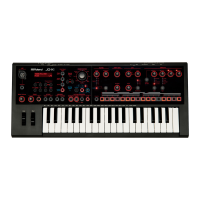Editing the Sound
Adjusting the Brightness and Thickness (FILTER)
The FILTER section contains parameters that
determine the character and distinctive features of
the sound.
[Cuto] knob (Cuto indicator)
This knob species the lter cuto frequency.
The lter whose indicator is lit is selected.
[Type] button
This button switches the lter type (for Analog
Synth, only LPF is available).
[Resonance] knob
Resonance emphasizes the sound in the region of the lter cuto
frequency.
Digital Synth/Drums part
You can use Digital LPF (Low Pass Filter), HPF (High Pass Filter), BPF
(Band Pass Filter), or PKG (Peaking Filter).
Analog LPF is not available.
You can change the slope of the lter.
&
For details, refer to “Parameter Guide” (PDF).
LPF HPF BPF PKG
Frequency
Resonance
Cut region
Analog Synth part
Only Analog LPF is available.
Analog LPF
Frequency
Resonance
Cut region
* Since the Analog LPF uses an analog circuit, the sound might be
aected by the temperature and the state of the power supply.
Adjusting the Loudness and Envelope (AMP/ENV)
The AMP section contains parameters that control the
volume.
The “envelope” is the shape of the volume changes from
when an instrument begins sounding until it decays to
silence. On a keyboard instrument, the envelope species
the way that the volume changes, starting when you press
a key, and how it decays after you release the key.
[Level] knob
This sets the volume.
[Envelope] knob
Turning the knob toward the left produces a shorter sound with a
stronger attack; turning the knob toward the right makes the attack
softer and the release longer.
Envelope
Volume
Time
Sound Ends
Note-oNote-on
A D R
S
A: Attack time Time from when you press the key until the sound reaches its
maximum level
D: Decay time Time over which the level decays from the maximum to the
sustain level.
S: Sustain time Volume at which the sound will be sustained while you hold
down the key
R: Release time Time over which the sound decays after you release the key
The [Envelope] knob eectively adjusts the A/D/S/R parameters in a
single operation.
For the Drums part you can edit this individually for each instrument (note).
If you want to edit A/D/S/R separately, enter “Tone Edit” and make
settings ([Menu/Write] button
0
choose “Tone Edit”).
&
For details, refer to “Parameter Guide” (PDF).
To obtain the Parameter Guide (PDF)
1. Enter the following URL in your computer.
http://www.roland.com/manuals/
2. Choose the “JD-Xi” as the product name.
Audio Flow in a Program
A program consists of four parts. The sound of each part is sent to the eect section.
Although the settings of the eect section are shared by the entire program, eects can be turned on/o individually for each part.
Analog Synth
OSC FILTER AMP
LFO
Drums
WAVE TVF TVA
LFO
Digital Synth 2
OSC FILTER AMP
LFO
Digital Synth 1
OSC
Select a sound
FILTER
Adjust the brightness
of the sound
AMP
Adjust the loudness
of the sound
LFO
* You can choose the combination of eect on/o settings for each part (p. 9).
EFFECTS
Eect 1
Distortion
Fuzz
Compressor
Bit Crusher
Eect 2
Flanger
Phaser
Ring Mod
Slicer
Delay
Delay
Reverb
Reverb
8

